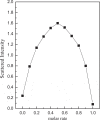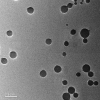Synthesis and characterization of phenylboronic acid-containing polymer for glucose-triggered drug delivery
- PMID: 32002087
- PMCID: PMC6968588
- DOI: 10.1080/14686996.2019.1700394
Synthesis and characterization of phenylboronic acid-containing polymer for glucose-triggered drug delivery
Abstract
Thermo-, pH- and glucose-responsive polymeric nanoparticles are of great interest in developing a self-regulated drug delivery system. The novel core-shell nanoparticles were synthesized by self-assembly of a phenylboronic acid-based block copolymer poly-(N-isopropylacrylamide)-block-poly(3-acrylamidophenylboronic acid) (PNIPAM136-b-PAPBA16) and a fluorescent complex glucosamine-poly(N-isopropylacrylamide)/Eu(III) (GA-PNIPAM)/Eu(III) based on the cross-linking between PBA- and GA-containing blocks in this work. The nanoparticles can be tuned via thermo-induced collapse or glucose-induced swelling at appropriate pH and temperatures; they had an average kinetic radius was about 80nm, and which showed excellent fluorescence. MTT assays revealed the nanocarriers had no significant cytotoxic response of the micelle when it was observed in the cell line over the concentration range from 0.1 to 1000 μg/ml at any exposure times.
Keywords: 103 Composites; 301 Chemical syntheses / processing; 501 Chemical analyses; D-glucosamine (GA); Poly(N-isopropylacrylamide) (PNIPAM); poly(3-acrylamido- phenylboronic acid)(APBA); lower critical solution temperature(LCST).
© 2019 The Author(s). Published by National Institute for Materials Science in partnership with Taylor & Francis Group.
Conflict of interest statement
No potential conflict of interest was reported by the authors.
Figures















Similar articles
-
Synthesis and Thermo-Responsive Behavior of Poly(N-isopropylacrylamide)-b-Poly(N-vinylisobutyramide) Diblock Copolymer.Polymers (Basel). 2024 Mar 18;16(6):830. doi: 10.3390/polym16060830. Polymers (Basel). 2024. PMID: 38543435 Free PMC article.
-
Synthesis and characterization of Eu(III) complexes of modified d-glucosamine and poly(N-isopropylacrylamide).Mater Sci Eng C Mater Biol Appl. 2017 Sep 1;78:603-608. doi: 10.1016/j.msec.2017.03.059. Epub 2017 Mar 9. Mater Sci Eng C Mater Biol Appl. 2017. PMID: 28576028
-
End-Functionalized Poly(N-isopropylacrylamide) with d-Glucosamine through Different Initiator from C-1 and C-2 Positions via Atom Transfer Radical Polymerization.Materials (Basel). 2016 Nov 10;9(11):913. doi: 10.3390/ma9110913. Materials (Basel). 2016. PMID: 28774036 Free PMC article.
-
Synthesis of poly(N-isopropylacrylamide)-co-poly(phenylboronate ester) acrylate and study on their glucose-responsive behavior.J Colloid Interface Sci. 2014 Oct 1;431:216-22. doi: 10.1016/j.jcis.2014.05.051. Epub 2014 Jun 6. J Colloid Interface Sci. 2014. PMID: 25014171
-
[Targeting of anticancer drug using intelligent polymers].Nihon Rinsho. 1998 Mar;56(3):644-8. Nihon Rinsho. 1998. PMID: 9549350 Review. Japanese.
Cited by
-
Synthesis, molecular docking and DFT analysis of novel bis-Schiff base derivatives with thiobarbituric acid for α-glucosidase inhibition assessment.Sci Rep. 2024 Feb 10;14(1):3419. doi: 10.1038/s41598-024-54021-z. Sci Rep. 2024. PMID: 38341468 Free PMC article.
-
Design of multiple-function matrix encapsulated with Marjoram extract to support cellular functions, stimulate collagen synthesis and decrease infection in wound.Sci Rep. 2024 Sep 10;14(1):21109. doi: 10.1038/s41598-024-71525-w. Sci Rep. 2024. PMID: 39256491 Free PMC article.
-
Topical bismuth oxide-manganese composite nanospheres alleviate atopic dermatitis-like inflammation.J Nanobiotechnology. 2023 Nov 16;21(1):430. doi: 10.1186/s12951-023-02207-4. J Nanobiotechnology. 2023. Retraction in: J Nanobiotechnology. 2024 Jul 5;22(1):397. doi: 10.1186/s12951-024-02692-1. PMID: 37974268 Free PMC article. Retracted.
-
Carbon Dots Embedded Hybrid Microgel with Phenylboronic Acid as Monomer for Fluorescent Glucose Sensing and Glucose-Triggered Insulin Release at Physiological pH.Nanomaterials (Basel). 2022 Sep 3;12(17):3065. doi: 10.3390/nano12173065. Nanomaterials (Basel). 2022. PMID: 36080102 Free PMC article.
-
In vitro α-glucosidase, docking and density functional theory studies on novel azide metal complexes.Future Med Chem. 2024;16(11):1109-1125. doi: 10.1080/17568919.2024.2342650. Epub 2024 May 20. Future Med Chem. 2024. PMID: 38916564 Free PMC article.
References
-
- Guan Y, Zhang Y.. Boronic acid-containing hydrogels: synthesis and their applications. Chem Soc Rev. 2013;42(20):8106–8121. - PubMed
-
- Ma R, Shi L.. Phenylboronic acid-based glucose-responsive polymeric nanoparticles: synthesis and applications in drug delivery. Polym Chem. 2014;5(5):1503–1518.
-
- Kuivila HG, Keough AH, Soboczenski EJ.. Areneboronates from diols and polyols1. J Org Chem. 1954;19(5):780–783.
-
- Brooks WLA, Sumerlin BS. Synthesis and applications of boronic acid-containing polymers: from materials to medicine. Chem Rev. 2016;116:1375–1397. - PubMed
LinkOut - more resources
Full Text Sources
Other Literature Sources
